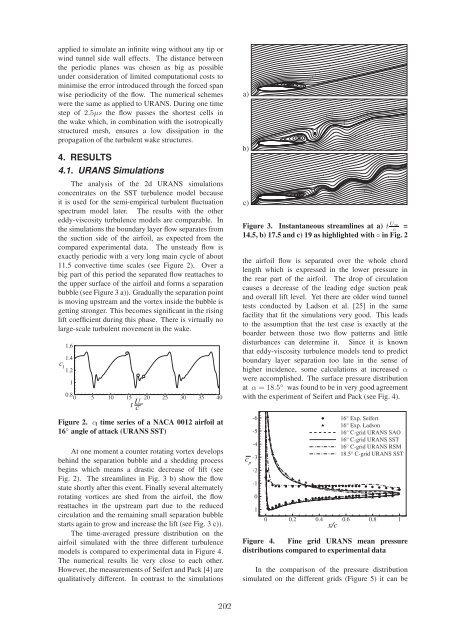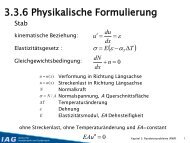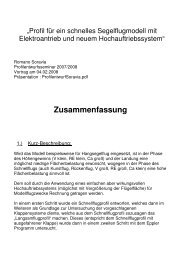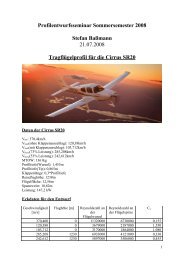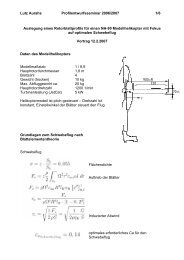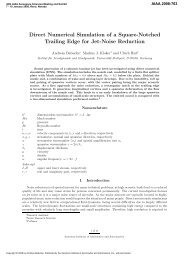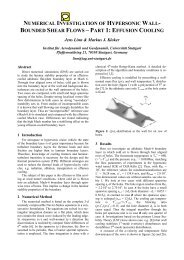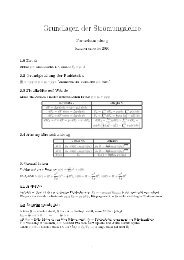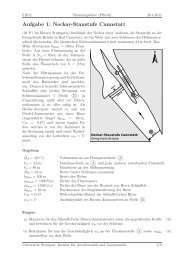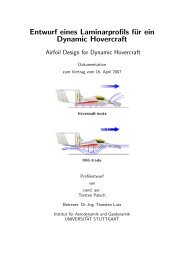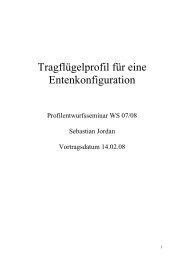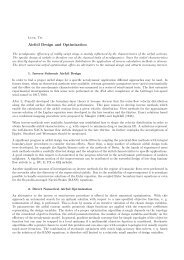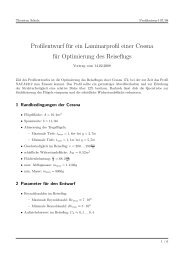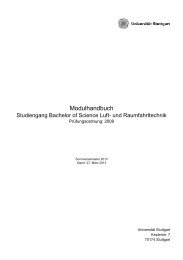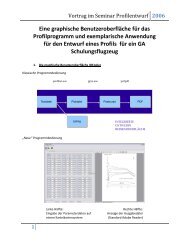NUMERICAL SIMULATION OF LOW-SPEED STALL AND ... - IAG
NUMERICAL SIMULATION OF LOW-SPEED STALL AND ... - IAG
NUMERICAL SIMULATION OF LOW-SPEED STALL AND ... - IAG
Create successful ePaper yourself
Turn your PDF publications into a flip-book with our unique Google optimized e-Paper software.
applied to simulate an infinite wing without any tip or<br />
wind tunnel side wall effects. The distance between<br />
the periodic planes was chosen as big as possible<br />
under consideration of limited computational costs to<br />
minimise the error introduced through the forced span<br />
wise periodicity of the flow. The numerical schemes<br />
were the same as applied to URANS. During one time<br />
step of 2.5µs the flow passes the shortest cells in<br />
the wake which, in combination with the isotropically<br />
structured mesh, ensures a low dissipation in the<br />
propagation of the turbulent wake structures.<br />
4. RESULTS<br />
4.1. URANS Simulations<br />
The analysis of the 2d URANS simulations<br />
concentrates on the SST turbulence model because<br />
it is used for the semi-empirical turbulent fluctuation<br />
spectrum model later. The results with the other<br />
eddy-viscosity turbulence models are comparable. In<br />
the simulations the boundary layer flow separates from<br />
the suction side of the airfoil, as expected from the<br />
compared experimental data. The unsteady flow is<br />
exactly periodic with a very long main cycle of about<br />
11.5 convective time scales (see Figure 2). Over a<br />
big part of this period the separated flow reattaches to<br />
the upper surface of the airfoil and forms a separation<br />
bubble (see Figure 3 a)). Gradually the separation point<br />
is moving upstream and the vortex inside the bubble is<br />
getting stronger. This becomes significant in the rising<br />
lift coefficient during this phase. There is virtually no<br />
large-scale turbulent movement in the wake.<br />
1.6<br />
1.4<br />
c l<br />
1.2<br />
1<br />
0.8<br />
0 5 10 15 20 25 30 35 40<br />
t U c ∞<br />
Figure 2. c l time series of a NACA 0012 airfoil at<br />
16 ◦ angle of attack (URANS SST)<br />
At one moment a counter rotating vortex develops<br />
behind the separation bubble and a shedding process<br />
begins which means a drastic decrease of lift (see<br />
Fig. 2). The streamlines in Fig. 3 b) show the flow<br />
state shortly after this event. Finally several alternately<br />
rotating vortices are shed from the airfoil, the flow<br />
reattaches in the upstream part due to the reduced<br />
circulation and the remaining small separation bubble<br />
starts again to grow and increase the lift (see Fig. 3 c)).<br />
The time-averaged pressure distribution on the<br />
airfoil simulated with the three different turbulence<br />
models is compared to experimental data in Figure 4.<br />
The numerical results lie very close to each other.<br />
However, the measurements of Seifert and Pack [4] are<br />
qualitatively different. In contrast to the simulations<br />
a)<br />
b)<br />
c)<br />
Figure 3. Instantaneous streamlines at a) t U∞ c<br />
=<br />
14.5, b) 17.5 and c) 19 as highlighted with◦in Fig. 2<br />
the airfoil flow is separated over the whole chord<br />
length which is expressed in the lower pressure in<br />
the rear part of the airfoil. The drop of circulation<br />
causes a decrease of the leading edge suction peak<br />
and overall lift level. Yet there are older wind tunnel<br />
tests conducted by Ladson et al. [25] in the same<br />
facility that fit the simulations very good. This leads<br />
to the assumption that the test case is exactly at the<br />
boarder between those two flow patterns and little<br />
disturbances can determine it. Since it is known<br />
that eddy-viscosity turbulence models tend to predict<br />
boundary layer separation too late in the sense of<br />
higher incidence, some calculations at increased α<br />
were accomplished. The surface pressure distribution<br />
at α = 18.5 ◦ was found to be in very good agreement<br />
with the experiment of Seifert and Pack (see Fig. 4).<br />
-6<br />
-5<br />
-4<br />
c<br />
-3<br />
p<br />
-2<br />
-1<br />
0<br />
1<br />
16° Exp. Seifert<br />
16° Exp. Ladson<br />
16° C-grid URANS SAO<br />
16° C-grid URANS SST<br />
16° C-grid URANS RSM<br />
18.5° C-grid URANS SST<br />
0 0.2 0.4 0.6 0.8 1<br />
x/c<br />
Figure 4. Fine grid URANS mean pressure<br />
distributions compared to experimental data<br />
In the comparison of the pressure distribution<br />
simulated on the different grids (Figure 5) it can be<br />
202


